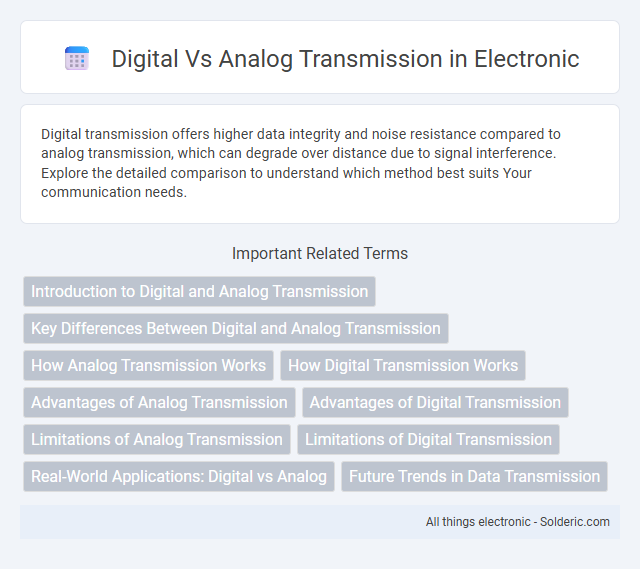Digital transmission offers higher data integrity and noise resistance compared to analog transmission, which can degrade over distance due to signal interference. Explore the detailed comparison to understand which method best suits Your communication needs.
Comparison Table
| Feature | Digital Transmission | Analog Transmission |
|---|---|---|
| Signal Type | Discrete binary signals (0s and 1s) | Continuous varying signals |
| Noise Immunity | High - less affected by noise | Low - more susceptible to noise |
| Bandwidth Efficiency | Generally more efficient | Less efficient |
| Data Integrity | Easier error detection and correction | Error detection difficult |
| Signal Processing | Complex, requires digital encoding/decoding | Simple, direct transmission |
| Transmission Distance | Longer distances with repeaters | Shorter distances due to signal degradation |
| Cost | Higher initial cost, lower maintenance | Lower initial cost, higher maintenance |
| Applications | Data networks, digital audio/video, computer communications | Traditional radio, telephone lines, analog broadcasting |
Introduction to Digital and Analog Transmission
Digital transmission converts information into binary code, enabling error detection and correction for improved signal integrity over long distances. Analog transmission conveys data through continuous signals varying in amplitude or frequency, closely representing the original waveform but prone to noise and distortion. Key technologies include pulse code modulation for digital and amplitude or frequency modulation for analog, influencing bandwidth efficiency and transmission quality.
Key Differences Between Digital and Analog Transmission
Digital transmission converts information into binary code, offering higher noise immunity, error detection, and efficient data compression, while analog transmission sends continuous signals that are more susceptible to noise and signal degradation. Digital systems provide easier multiplexing, security, and compatibility with modern computing devices, whereas analog systems rely on varied signal amplitude or frequency, making them more vulnerable to distortion over long distances. Your choice between digital and analog transmission depends on factors such as signal quality requirements, transmission distance, and the need for data integrity.
How Analog Transmission Works
Analog transmission works by continuously varying a carrier signal's amplitude, frequency, or phase in direct proportion to the analog input signal, such as sound or light waves. This modulation allows the transmission of real-world information over communication channels like telephone lines or radio waves. Signal degradation and noise interference can affect the quality of analog transmission, leading to distortion and loss of fidelity.
How Digital Transmission Works
Digital transmission works by converting data into binary signals, representing information as a series of 0s and 1s. These discrete signals are transmitted over communication channels with higher noise immunity and reduced error rates compared to analog signals. Your data integrity is maintained through techniques like error detection and correction, ensuring reliable and efficient communication.
Advantages of Analog Transmission
Analog transmission offers advantages such as simplicity in design and compatibility with a wide range of existing equipment, making it cost-effective for certain applications. It provides continuous signal representation, which can capture real-world phenomena like sound and light more naturally in specific contexts. Your system may benefit from analog's lower latency and ease of processing for signals that do not require digital conversion.
Advantages of Digital Transmission
Digital transmission offers superior noise resistance, enabling clearer signal quality over long distances compared to analog transmission. It supports efficient data compression and encryption, enhancing both bandwidth utilization and security. Digital systems facilitate easy integration with computer networks, allowing seamless digital communication and error correction techniques.
Limitations of Analog Transmission
Analog transmission faces significant limitations such as susceptibility to noise and signal degradation over long distances, which leads to poor signal quality and increased error rates. The continuous nature of analog signals makes it difficult to implement effective error detection and correction, reducing reliability in data communication. Moreover, analog systems require more bandwidth for transmission and are less efficient compared to digital systems, limiting their use in modern high-speed networks.
Limitations of Digital Transmission
Digital transmission faces limitations such as susceptibility to noise and signal degradation over long distances, which can cause bit errors and reduce data integrity. Bandwidth constraints also limit the maximum data rate, requiring complex modulation techniques to enhance capacity. Furthermore, digital systems demand higher processing power and more sophisticated hardware, increasing cost and complexity compared to analog transmission.
Real-World Applications: Digital vs Analog
Digital transmission powers modern communication systems like fiber-optic networks, mobile phones, and streaming services, offering higher data integrity, efficient error correction, and scalability. Analog transmission remains vital in traditional broadcasting, AM/FM radio, and certain sensor technologies due to its simplicity and continuous waveform representation. Your choice between digital and analog transmission depends on specific application requirements such as signal quality, bandwidth, and environmental factors.
Future Trends in Data Transmission
Future trends in data transmission emphasize increased adoption of digital technology due to its superior noise immunity, higher data rates, and enhanced security features. Emerging innovations like 5G, fiber-optic communication, and quantum data transmission promise unprecedented bandwidth and ultra-low latency for real-time applications. Analog transmission remains relevant in legacy systems, but its role diminishes as digital infrastructure evolves to support complex, large-scale data networks worldwide.
Digital vs Analog transmission Infographic

 solderic.com
solderic.com